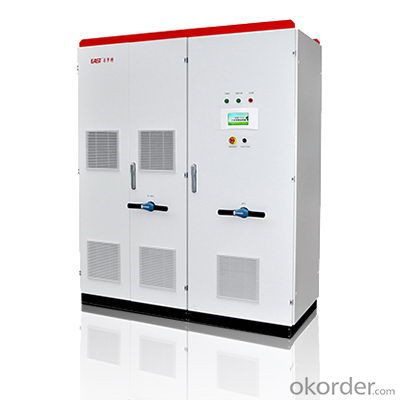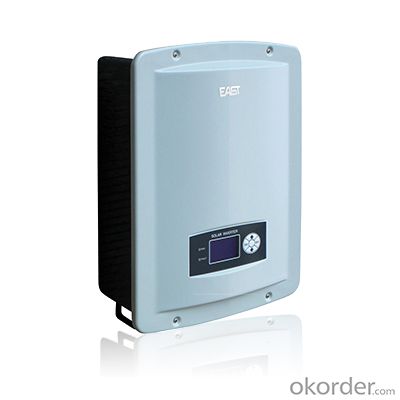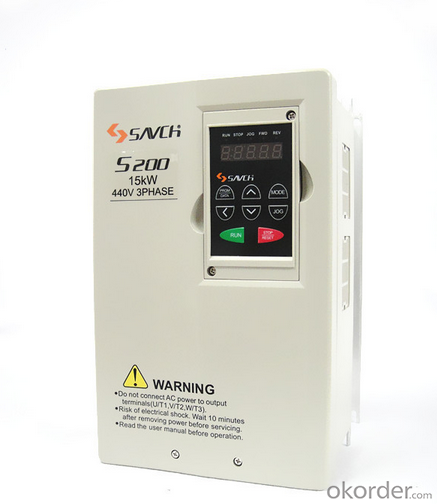Trina Solar Inverter for Residential and Small Commercial PV Installations
- Loading Port:
- China main port
- Payment Terms:
- TT or LC
- Min Order Qty:
- 10 carton
- Supply Capability:
- 20000 carton/month
OKorder Service Pledge
OKorder Financial Service
You Might Also Like
EA4KDL/EA4K6DL/EA5KDL/EA6KDL
EA4KDL / EA5KDL / EA6KDL is designed for residential and small commercial PV installations. This inverter has dual input section to process two strings with independent MPPT, high speed and precise MPPT algorithm for real-time power tracking and energy harvesting, as well as transformerless operation for high performance efficiencies of up to 97.5%. The wide input voltage range makes the inverter suitable to low power installations with reduced string size. This outdoor inverter has been designed as a completely sealed unit to withstand the harshest environmental conditions.
● Transformerless, maximum efficiency up to 97.5%
● Dual input sections with independent MPP tracking, allows optimal energy harvesting from two sub-arrays oriented in different directions
● Wide MPPT range, convenient for module configuration
● High speed and precise MPPT algorithm for real time power tracking and improved energy harvesting
● High reliability with full protective functions
● Ideal for outdoor installations
● Water-proof direct plug-in terminals
● Multilingual LCD, easy to operate
● Integrated multi-communication interfaces, easy to monitor
● TÜV, AS4777, CE, CQC certification
Specification/Type | EA4KDL | EA4K6DL | EA5KDL | EA6KDL |
Input (DC) | ||||
Max DC Power | 4400Wp | 5000Wp | 5500Wp | 6600Wp |
Max DC Voltage | 520V | 520V | 520V | 520V |
Recommend PV Array DC Voltage | 480V | 480V | 480V | 480V |
Full-load MPPT Voltage Range | 180-420V | 180-420V | 180-420V | 180-420V |
Number of Independent MPPT | 2 | 2 | 2 | 2 |
Max DC Current for Each MPPT | 12A | 14A | 15A | 18A |
Number of DC Inputs | 4(2 for each MPPT) | 4(2 for each MPPT) | 4(2 for each MPPT) | 4(2 for each MPPT) |
MPPT Efficiency (Static) | 99.5% | 99.5% | 99.5% | 99.5% |
Output (AC) | ||||
Nominal AC Power | 4000W | 4600W | 5000W | 6000W |
Nominal AC Voltage | 230Vac | 230Vac | 230Vac | 230Vac |
Nominal AC Current | 18A | 20A | 22A | 26A |
Nominal Frequency | 50Hz/60Hz | |||
Frequency Tolerance Range | 47.5-50.2Hz/57.5-60.2Hz | |||
Distortion (THD) | <3% (at rated power) | |||
Output DC Current Injection | <0.5% (at rated current) | |||
Power Factor (Cos phi) | >0.99 | |||
Number of Grid Phases | 1 | |||
System Parameters | ||||
Max Efficiency | 97.6% | 97.6% | 97.6% | 98.6% |
Euro Efficiency | 97.0% | 97.0% | 97.0% | 97.3% |
Night Consumption | 0W | |||
Topology | Transformerless | |||
Acoustic Noise Level | 50dB(A) | |||
Operation Temperature Range | -20℃~+60℃ | |||
Relative Humidity | 4~100%(no condensation) | |||
Protection Type | IP65 | |||
Above Sea Level | 1000m | |||
Structure Parameters | ||||
Dimensions(W×D×H) | 450×200×540mm | |||
Weight | 25kg | 25kg | 28kg | 28kg |
Others | ||||
Communication | RS485,USB(Optional),Ethernet (Optional) | |||
Display | Wide-screen LCD | |||
· Q. What's lifetime of a UPS ?
Most plug-in UPS are workable for at least five years. We'd advise you to change the batteries every three to four years. For larger equipment, we maintain equipment for twenty years old and still going strong.
· Q. How to maintain a UPS ?
There are three simple methods: Never overload your UPS, never connect any home electronic devices such as cooling fan to your UPS. This may cause malfunction of your UPS. Discharge the battery in a consistent interval, once a month or once two months. You can do this by turning on the UPS without connecting the mains.


- Q: What is the role of Maximum Power Point Tracking (MPPT) in a solar inverter?
- The role of Maximum Power Point Tracking (MPPT) in a solar inverter is to optimize the power output from the solar panels by constantly adjusting the voltage and current to ensure that the solar panels are operating at their maximum power point. This allows the solar inverter to efficiently convert the DC power generated by the solar panels into AC power for use in homes or businesses. By tracking and adjusting the maximum power point, MPPT technology maximizes the overall energy production and improves the overall efficiency of the solar inverter system.
- Q: Can a solar inverter be used with bifacial solar panels?
- Yes, a solar inverter can be used with bifacial solar panels. Bifacial solar panels can generate electricity from both sides, capturing sunlight from both the front and back surfaces. The solar inverter is responsible for converting the DC power generated by the solar panels into AC power that can be used in homes or fed into the grid. Therefore, a solar inverter is an essential component for any solar panel system, including those with bifacial panels.
- Q: Can a solar inverter be connected to a smart home or monitoring system?
- Yes, a solar inverter can be connected to a smart home or monitoring system. This integration allows for real-time monitoring, remote control, and data analysis of the solar energy production and consumption within a smart home or monitoring system.
- Q: Can a solar inverter be used in three-phase systems?
- Yes, a solar inverter can be used in three-phase systems. In fact, there are specific three-phase solar inverters designed to convert the DC power generated by solar panels into AC power for utilization in three-phase electrical systems. These inverters are capable of efficiently managing the power flow and ensuring balanced distribution across all three phases.
- Q: How does a solar inverter handle variations in grid voltage?
- A solar inverter handles variations in grid voltage by continuously monitoring the voltage levels and adjusting its output accordingly. It has built-in voltage regulation and control mechanisms that help maintain a stable and consistent output voltage, even when there are fluctuations in the grid voltage. This ensures that the solar inverter can efficiently convert the DC power generated by the solar panels into AC power that is synchronized with the grid, regardless of any voltage variations in the grid.
- Q: Can a solar inverter be used with different battery chemistries?
- Yes, a solar inverter can be used with different battery chemistries as long as the inverter is compatible with the specific battery chemistry and its voltage requirements. However, it is important to ensure that the inverter is designed to work efficiently with the particular battery chemistry to avoid any compatibility issues or potential damage to the system.
- Q: Can a solar inverter be used with a solar-powered outdoor lighting system?
- Yes, a solar inverter can be used with a solar-powered outdoor lighting system. A solar inverter is responsible for converting the direct current (DC) generated by solar panels into alternating current (AC) that can be used to power various devices, including outdoor lighting systems. By connecting the solar panels to a solar inverter, the generated energy can be efficiently transformed and utilized for powering the lighting system, ensuring sustainable and renewable lighting solutions.
- Q: Can a solar inverter be used with solar-powered water heaters?
- No, a solar inverter cannot be directly used with solar-powered water heaters as they serve different purposes. A solar inverter is used to convert the direct current (DC) electricity produced by solar panels into alternating current (AC) electricity for use in homes or businesses. On the other hand, solar-powered water heaters utilize the sun's energy to heat water directly, without the need for electricity conversion.
- Q: Can a solar inverter be connected to a smartphone app for monitoring?
- Yes, a solar inverter can be connected to a smartphone app for monitoring. Many modern solar inverters have built-in Wi-Fi or Bluetooth capabilities that allow them to connect to a smartphone app. This app provides real-time monitoring of the solar system's performance, including energy production, consumption, and any potential issues or faults. It also allows users to remotely control and adjust settings of the inverter for optimized energy management.
- Q: What is the standby power consumption of a solar inverter?
- The standby power consumption of a solar inverter refers to the amount of power it consumes when it is not actively converting solar energy into usable electricity. This power consumption is typically very low, often ranging from a few watts to a few tens of watts, depending on the model and efficiency of the inverter.
Send your message to us
Trina Solar Inverter for Residential and Small Commercial PV Installations
- Loading Port:
- China main port
- Payment Terms:
- TT or LC
- Min Order Qty:
- 10 carton
- Supply Capability:
- 20000 carton/month
OKorder Service Pledge
OKorder Financial Service
Similar products
Hot products
Hot Searches
Related keywords























